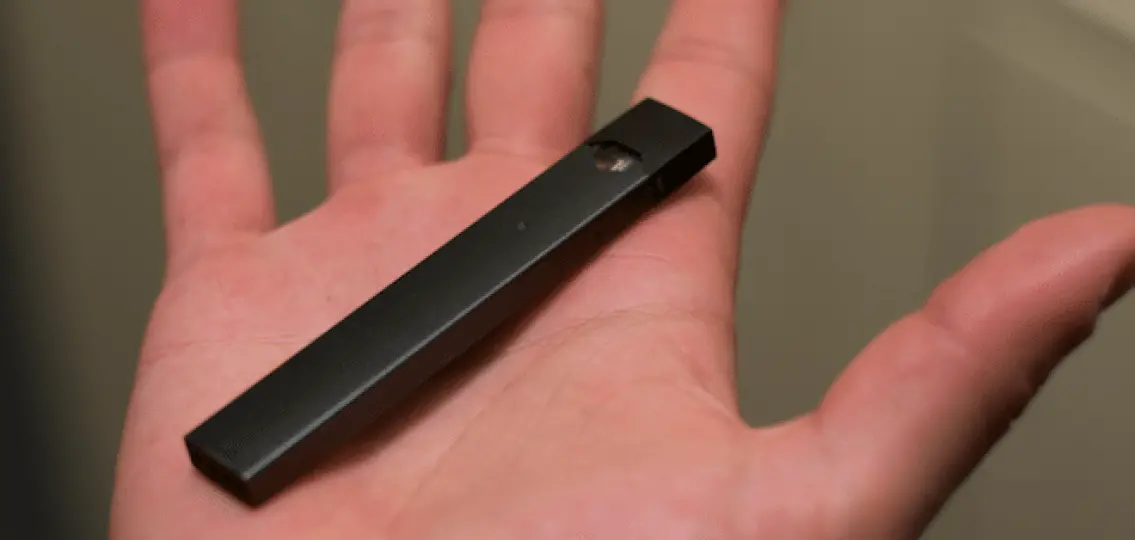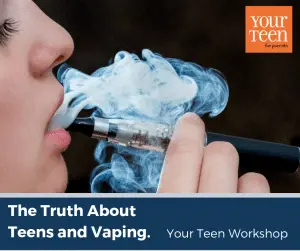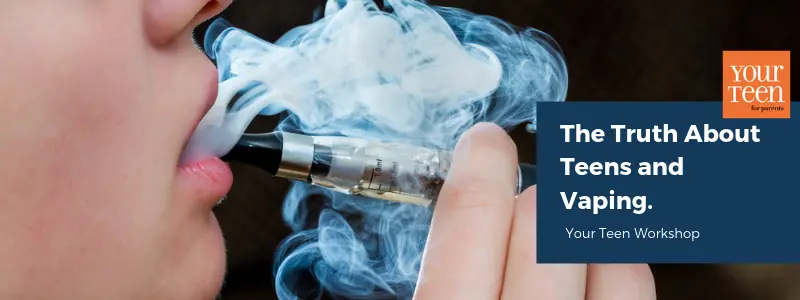What are teenagers inhaling—and how is it affecting them?

Parents have been asking these questions for generations, and they likely will continue to with the rise of vaping and other new products. If you want to know more about what your kids and their friends might be inhaling—and what the side effects are—read on.
Electronic Cigarettes (Vaping and Juuling)
With electronic cigarettes, nicotine, flavorings, and other chemicals are heated to create a water vapor that is then inhaled and exhaled. Common devices used to inhale the vapor include vape pens, e-cigarettes, and Juuls—an e-cigarette shaped like a USB flash drive. Juuls have become increasingly common among teens because they are small and easily hidden.
Q: What are the side effects?
Most e-cigarettes contain nicotine, the addictive drug found in regular cigarettes that can harm the brain, particularly the parts that control attention, learning and impulse. Vaping nicotine can also effect your teeth and dental health. Juuls typically have more nicotine than other types of e-cigarettes. One Juul pod has as much nicotine as a pack of cigarettes.

Vaping liquids also contain other toxic chemicals like propylene glycol and glycerol, which have been linked to cancer, respiratory disease, and heart disease. There is also evidence that the chemicals in vape flavorings can harm the endothelial cells that line blood and lymph vessels.
Q: How addictive is it?
The nicotine in e-cigarettes, as with traditional cigarettes, is highly addictive, particularly to teens whose brains are still developing. The use of extra-strength cartridges means teens can get even more nicotine from vaping than from regular cigarettes. Reports also suggest that vaping and juuling increase the likelihood and frequency of smoking traditional cigarettes in the future.
Q: Is it legal?
Vaping is illegal for anyone under 18. The American Academy of Pediatrics recommends changing the minimum legal age to 21. Some states have recently raised the age to 21. Most recently, some states have banned flavored e-cigarettes.
Q: How many teens vape or juul?
According to reports about 20 percent of high school students and about 5 percent of middle school students vape. That translates to about 3.6 million minors in the US using e-cigarettes.
Cigarettes
Reports from the Surgeon General reveal that cigarettes have become more dangerous over time and have increased the risk of the most common type of lung cancer.
Q: What are the side effects?
When a teen inhales smoke from a burning cigarette, he inhales over 7,000 chemicals, more than 70 of which are linked to cancer. Cigarettes not only contribute to increased cancer risk but also increased risks of coronary heart disease and stroke.
Q: How addictive is it?
The nicotine in cigarettes is highly addictive. It’s been found that three out of four teens who smoke cigarettes will continue to smoke as adults.
Q: Is it legal?
You must be over 18 to buy and smoke cigarettes.
Q: How many teens smoke cigarettes?
Over the past decade or so, the number of teens smoking cigarettes has declined because of the rise in e-cigarettes. About 11 percent of high school students, and less than 5 percent of middle school students, smoke cigarettes.
Marijuana
Also known as weed, pot, dope, or grass, marijuana can be consumed in a variety of ways, including smoked as cigarettes or in pipes or bongs, vaped in e-cigarettes, eaten in baked goods or candy or applied as an oil to the skin.
Q: What are the side effects?
Marijuana can cause changes in perception, lack of coordination, difficulty with problem solving, increased heart rate and respiratory problems. Studies have also found that marijuana usage is associated with learning difficulties, increased aggression and increased risks of psychosis.
Q: How addictive is it?
Marijuana is addictive, particularly for teens. According to recent research, one in six teens who use marijuana often become addicted. Another study found that 17 percent of adolescents become addicted to marijuana, compared with 9 percent of adults.
Q: Is it legal?
Currently, in 10 states and the District of Columbia, recreational marijuana use is legal for people 21 and over. Other states allow the use of medical marijuana.
Q: How many teens use marijuana?
Marijuana use by teens is reportedly at its highest in 30 years, but a relatively small number of teens use it regularly. A recent study found that 10 percent of eighth graders had used marijuana in the past year, while nearly 36 percent of high school seniors had used marijuana in the past year. Instances of vaping marijuana have increased slightly in the past year for all teens.
Spice and K2
Spice and K2 are names for a synthetic marijuana made from a mixture of chemicals and herbs. They are marketed as incense or potpourri and are referred to as “fake marijuana.” Synthetic marijuana can be smoked or used in herbal tea or e-cigarettes.
Q: What are the side effects?
These substances can cause rapid heart rate, elevated blood pressure, confusion, hallucinations, paranoia, and even death. It is important to note that there are many different blends, so it’s not always entirely clear what is being inhaled.
Q: How addictive is it?
Synthetic marijuana can be addictive, particularly when frequent use over time. Users can experience withdrawal symptoms.
Q: Is it legal?
This is a tricky question. The Drug Enforcement Agency has banned synthetic cannabinoids, but manufacturers change the ingredients to work around the law.
Q: How many teens use synthetic marijuana?
Reports show that about 1.5 percent of middle school students and 3.5 percent of high school students use synthetic marijuana.
Hookah
A hookah is a water pipe used to smoke flavored tobaccos. Hookah lounges have become popular, particularly near college campuses, and smoking hookahs has become a social activity.
Q: What are the side effects?
Hookah users typically smoke for longer periods of time and inhale more toxins than traditional cigarette smokers. The side effects are largely the same as with cigarettes.
Q: How addictive is it?
Because users inhale more nicotine, hookah smoking can be even more addictive than cigarettes.
Q: Are hookahs legal?
Teens under the age of 18 cannot purchase or use hookahs.
Q: How many teens use hookahs?
While recent research indicates there’s been an increase in use of hookahs among high school seniors, only around 11 percent of middle and high school students, total, claim to have tried hookah smoking.
Additional resources:
Electronic cigarettes
https://nida.nih.gov/research-topics/tobacconicotine-vaping
https://www.cdc.gov/tobacco/basic_information/e-cigarettes/
https://nida.nih.gov/research-topics/tobacconicotine-vaping
Marijuana
https://nida.nih.gov/research-topics/cannabis-marijuana
https://nida.nih.gov/research-topics/cannabis-marijuana
Spice and K2
https://nida.nih.gov/publications/drugfacts/synthetic-cannabinoids-k2spice
https://nida.nih.gov/research-topics/synthetic-cannabinoids-k2spice





